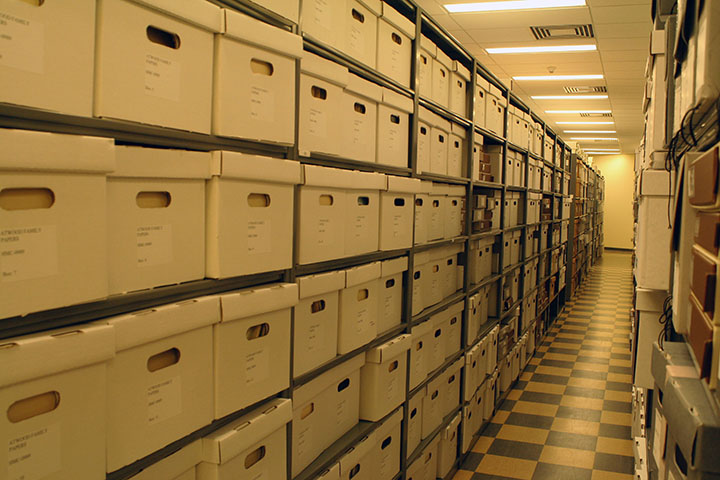Becky the Archives’ intern here, ready to ask all the “dumb” questions so you don’t have to! I’ve been working in the UAA Archives this past semester, and I’ve stumbled across a few common areas of confusion that I’ve decided to address for those of us just dipping our toes in the archival ocean. Arlene posted a handy guide to beginning your research at the Archives earlier this year that you may also want to check out. But if you’ve always wondered where exactly we keep the records and how you’re supposed to find the exact one you want, I’m here to help!
Where is everything?
As soon as you enter the Archives, you’ll notice that we don’t have our collections laid out on shelves like you’d find in the library. That’s because most of our items are older, unique, or rare and need to be stored in a temperature and humidity controlled environment. This keeps the records in better condition for future use. So, the records are kept in “the stacks,” a back room that meets the storage needs of the items.
The archivists can retrieve the collection you want to see, and you can browse through it in the comfort of our research room.
But how do I see what you have?
What an excellent question! There are a number of ways you can peruse our collections, and the first doesn’t require you to move from your bed. Our website has guides to our collections. You can go through them alphabetically by the creator’s last name, by topic, or by typing in a keyword search in our search box. Some of our collections (or small portions of them) are even viewable online in Alaska’s Digital Archives. Of course, you can always email or call us if you have questions or need assistance.
If you come into the Archives in person, we have all our collection guides in binders for you to use. You’ll also have the benefit of an archivist sitting in the same room, ready to answer your questions and guide you to collections.
What’s a collection guide and how do I use it?
A collection guide (or as you may hear in other archives, a finding aid) is the Sparknotes version of the collection. It’s a document that gives you the background of a collection and other information you need to a) see if it’s a collection you want to view and b) find particular portions of interest. The collection guide provides biographical or historical information on the creator of the collection, tells you the time frame it was created in, and describes the kinds of materials in it (for example, it will say whether there are photographs in the collection or not). For larger collections, the guide will also contain a contents list that briefly details what items are in which box or folder. Other information, such as the preferred citation and who holds the copyright to the collection, is also in the collection guide.
Collection guides are meant to simplify your search, but if you’re ever confused by one (and most people are at first), feel free to ask your friendly local archivist.
All right, one more – what’s a collection?
A collection is a group of records that share a creator and/or were created at the same time or for the same event. The creator might have been an individual, a family, a business, an association – we’ve got all sorts in the archives! Collections can be made up of personal papers and correspondence, memoranda, images, film, maps, and many other types of records that provide evidence of life and society in Alaska. Some of the collections are historical while others contain records from today. If there’s a particular type of collection you’re looking for, don’t hesitate to ask.
Here’s just two examples of the types of records that make up a collection:
So there you have it. Do you have other questions about archives and how they work? Let us know!








